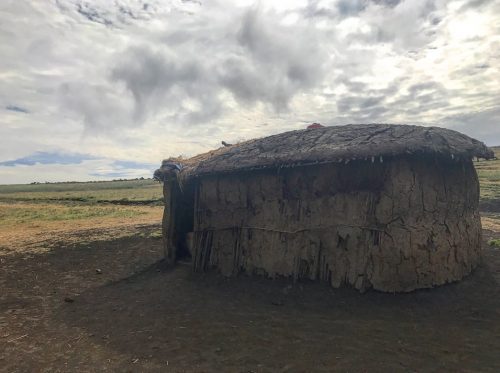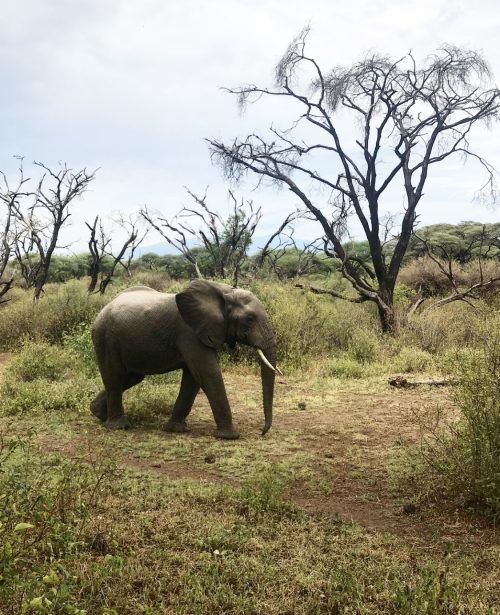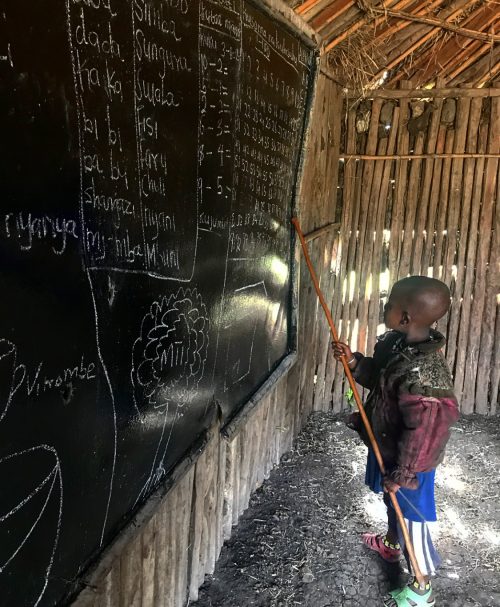 The Maasai tribe, one of the most researched groups of people residing in the eastern part of the rich African continent, welcomed me and my curiosity to their village this March. It was impossible to understand the bravery of Maasai women until I met them and saw with my own eyes what is it like to live in a world, that for us on the other side of happiness, seems as a parallel universe. When you meet them and hear their stories, you can never be indifferent again. Never again will you be just an observer.
The Maasai tribe, one of the most researched groups of people residing in the eastern part of the rich African continent, welcomed me and my curiosity to their village this March. It was impossible to understand the bravery of Maasai women until I met them and saw with my own eyes what is it like to live in a world, that for us on the other side of happiness, seems as a parallel universe. When you meet them and hear their stories, you can never be indifferent again. Never again will you be just an observer.
I embarked on a Cesna Caravan 208 with 7 other passengers. Slightly nervous looks and long silence gave away that we were a group of amateur explorers, with only hungry for adventures in common. In the co-pilot seat, I flew over Kilimanjaro to Arusha. Two more hours from this small town, and I got to an even smaller Karatu, finding myself one step closer to the big crater of Ngorongoro.
Nowadays, it’s a part of a Conservation center that plays a major role in preserving Tanzania's wildlife, as well as providing conditions for a harmonious life of the Maasai tribe. Facing modernization and all the charms of the new century, the tribe is being provided with conditions which allow their semi-nomadic spirit to be free. According to extensive research of this group of African tribes, Maasai originated from the lower Nile in northwestern Kenya.At the end of 15th century they migrated to south and finally settled in the region that we now know as central Tanzania sometime between the 17th and 18th century.
Traditional dance
Even a glance at a member of the Maasai tribe in a traditional shuka treading savannas of Africa is a feast for the eyes of curious travelers. Red is the color that Maasai warriors are wearing most often, because by some beliefs it portrays the strongest defiance in their potential encounters with wild beasts.They welcomed us with traditional dance in their village of 17 houses. Women, humming the melody on my left side, and men performing a dance of jumping on the plains to my right. The one who jumps the highest is considered the best dancer.
Watching a group of young warriors swinging their spears in front of the vast lands of what was once a mountain the size of Kilimanjaro, even the one who does not believe in God must think that he is somewhere near. Each movement of their body shows the incredible courage of a young man who feels like he has conquered the world.
Man is traditionally the protector of the house and tribe. Morans, as Maasai warriors are called in the tribal Maa language, can have an unlimited number of women with whom they will make a family. The elder of this tribe has 11 women and with them 73 children. His son and deputy in the village proudly introduced me to his family home made of what they have available – cow dung, wood and ash used for roof, serving as a thermal isolator and protection against water.
,,All seven of my children were born here, right on this bed,” he said to me, pointing to a small living room decorated with bamboo trees. The smell of recently cooked lunch was still lingering in the air.
Cocktails made of blood and milk
Right next to the living room is a small room for the cattle that sometimes sleeps inside. There is 126 of them living in this village in the valley of Ngorongoro crater.
They have herds of cows, sheep and goats they bread and useas a primary source of food. Traditional meal in this tribe is raw or cooked meat served with a special cocktail made of blood and milk. This is also their main source of protein. Its preparation is simple –jugular vein of a cow is cut by a sharp arrow, and a dried balagash is placed beneath it – this fruit has the shape of a small bowl when it’s dry. It is then mixed with milk. The whole village enjoys this unusual cocktail, both children, women and men. The bleeding of a wounded cow is stoppedwith grease and for the next few days women will take care of it.
The Maasai don’t hunt wildlife. They live with nature and sometimes they must protect themselves from it. Therefore, to prevent the dangerous proximity of the animals, they build fences of acacia wood thorns around their houses.They believe in the Sun, worship the mountain, and pray in front the old fig tree to their god, Enkai (Ngai).
From where I was standing, nature was unrealistically beautiful, but all that unexplored land can be cruel and unforgiving. Inside of the crater, everyone is fighting to survive. Inside of these 300,000 square kilometers with low vegetation, the Maasai tribe is together with the wildlife in the race for survival. Ngorongoro is the home of the big five – lion, buffalo, leopard, rhino and elephant are what most tourists want to see when they break into the African Safari adventure. It seems that I had luck in mine, because just a few meters from our jeep I saw them all, except the leopard. However, my curious eyes were fed by the sight of a beautiful young cheetah, the fiercest and fastest wild cat, capable of reaching a speed of 110 km / h, but only able of maintaining it for no longer than ten seconds. David, my guide and wildlife specialist for more than 30 years, didn’t miss the opportunity to tell me how lucky I was to see lions mating, cheetah in action and black rhinos, threatened to extinct because the poachers use their horn for natural viagra, especially popular in the Arab world.
And he was right, I was really lucky. I've never seen anything so beautiful and mighty before.
The herds usually have familiar routes, keeping each other’s backs and knowing the timings when they should be on alert because the predators are ready for a new meal. However, the rules do not really exist and the surprises are bound to happen.
Understanding these conditions, who can blame the sixteen-year-old who seeks the opportunity to prove courage to his community, for having an unstoppable impulse of self-defense when he spots a graceful lioness ready to attack on the other side of the horizon. If it does not retreat fast enough and does not respect the space of its potential opponent, the lioness will soon be faced with a sharpened spear of one of the strongest warriors under the African sun. If such a thing happens, Maasai will inform the Ngorogoro Conservation Center service that will question whether this was really an unfortunate case of self-defense. If Maasai tribe lost 1 cow in such an encounter, they will be compensated with three calves. These are clearly defined rules.
Patriarchal society
This is a patriarchal society in which a woman is inferior to men, children and the entire tribe, deprived of the possibility of education or choice. Unlike men, a woman can’t get divorced, and if she becomes a widow, she will be taken care of by one of the elders of the tribe. Nevertheless, from all the practices that women of the 21st century will frown upon reading these lines because they support emancipation and equal rights, the cry of despair comes talking about the circumcision of girls. Although the Maasa is have slowly begun to abandon this cruel practice in last ten years, female genital mutilation is still illegally performed in parts of Tanzania, at the request of tradition. It is important to understand that circumcision in Maasai culture is not religious, but a cultural moment that represents the ritual of the transition of a girl into a ,,complete woman”; from a boy to a brave warrior. It is therefore not surprising that mythology plays a major role here.
According to statistics, due to this brutal practice more than 2/3 of girls that have undergone circumcision suffer pain in sexual intercourse and during childbirth.To justify this savage ritual against girls, it’s all about little Naipei. This name is very well known among the women of Maasai tribe. Naipei became a symbol of a disobedient, not to be trusted, uncontrollable “female” who embarked on a relationship with a man who was considered a tribal enemy. In order to show her the right path and prevent her from new wrongdoings, she was subjected to clitoridectomy, a procedure of removing all or part of the clitoris that is aimed to reduce or completely extinguish her sexual instincts. The story of Naipei has become a lullaby to the curious and frightened eyes of little girls in the Maasai tribe who still need to understand that without it they are neither pure nor complete.
Until the ,,trim”, the girls go to school with boys. Learning Swahili and English language, geography and basics of mathematics should just be the beginning. But the day she stops being a girl, she is denied her education, because now she is ready to become a woman, too soon a mother.
Today, it seems like non-governmental organizations of Kenya and Tanzania have sobered up and activated about resolving this issue. They are taking important steps to prevent this practice, which, although it is taking place in another 27 African countries, really has no place in the 21st century. It appears that girls are on the way to a more beautiful future. The world is awake about the matter as well. The consequences of female genital mutilation for their health, as well as violations of their basic human rights are being discussed on panels worldwide.For this reason it is often that the parents of circumcised girls caught in that act or immediately after, are arrested and the girls are taken into shelters. In cooperation with the state, numerous NGOs of these two East African countries, with a population of about one million and a half members of the Maasai tribe living there, are still building mechanisms to prevent these cruel practices. The most important among them is education of girls about their rights of choice, the education of their peers – boys who should not be rejecting uncircumcised girls as not worthy and certainly parents who must understand that times have changed and that their girls can still be valuable members of the Maasai tribe, without pain and trauma.
Society is becoming aware of the problems, hazards and accidents that remain forever awake in that morning when an innocent little girl became a woman. Morning when all the excitement of growing up died in the hands of the cutter. That morning, when a sharp knife reminded her she will not be like Naipei. The circumstances seem to improve, but the question still remains unanswered – how many screams muffled with pillows will a Maasai woman have before she has a peaceful sleep?
Rituals
Circumcision of boys is still a compulsory and an act of initiation for the future warrior. It is done without anesthesia, often in non-sterile conditions, with a sharp blade when the boy is in late puberty. My guide in the Tanzanian adventure, David, is one of the Maasai who was born and grew up in a village of somewhat more modern customs. He recalls preparing for this very special ceremony in which the crying, screaming, hissing or sudden movement caused by pain are considered a great weakness and are a shame for the entire male part of the family.
,,Special psychological preparation is needed, because the pain, I remember it even today more than 30 years later, is the most realistic thing I could feel in my life. For weeks, I prepared by telling myself that if my father could, and his father too and all the men for generations back, I would certainly not be the one who would shed the first tear,” David recalls.
And he didn’t.
The night before the big act, cold water is poured into the ceramic vessel. As soon as the first grass on the savannas of the Ngorongoro crater senses the sun, the frightened boy is getting ready to become a warrior. The tribal circumcision specialist (they call him the cutter)splashes the boy with cold water as the first shock for his little body that just left a warm bed. One of the older warriors then puts his arms around the boy's neck and back to minimize the movements cause by pain emerging any moment.The procedure takes about ten minutes. These are certainly the longest ten minutes in the life of a little warrior.
The recovery process lasts for three to four months, but the main sign of recognizing circumcised boys is the black traditional shuka that the young men will wear for the next eight to nine months. In addition, they will have black and white decorated faces. All this is a sign to the whole world that they have successfully passed the initiation process and are now learning Maasai traditions that will become the way of life. On the chests they are wearing metal jewelry given to them by proud mothers. On the head,a decoration made of feathers of birds, killed with their bow and arrow. They are no longer boys. Now, at the very end of the journey, Maasai is a warrior who will defend his tribe and take care of the cattle which is their main duty. Maasai believe that when God parted heaven and earth, he entrusted them with all the cows. And so it remains in their eyes to this day.
There are about 30 women in this village of Maasai tribe. All those older than 14 are somebody’s wives, none of them is single. An important tribal tradition is that it is the woman who builds the house. She collects everything, except larger pieces of wood that serve as support poles and are brought in by men. She needs about three weeks to give her family a safe home and a roof over their head. Another job they are committed to is tribal crafts, handmade traditional jewelry and figurines made of bamboo, banana and mango wood. They are sold in the village and the nearby tourist centers of the Ngorongoro Center. Every day Maasai women proudly wear jewelry made of metal, wire and multicolored beads. Their hair is cut short, hygiene being the primary reason and they say that they would not have it any other way. Exploring their uniqueness, I saw a young Maasai mum looking at my long hair colored in shades of dark grapes. She thought to herself, perhaps she could have it for one day.

Seventeen matunyas (in maa language: matunya, traditional Maasai house) compiled into a circle are temporary homes of this tribe. When the drought comes, it's time to move the tribe some 30 kilometers in the direction of the nearest water. This is a time that requires special caution and good organization, because everybody in the Ngorongoro crater, Maasai and wild beasts, go in search of water. At the place where the elders of the tribe determine a new place to live in the coming months, Maasai women will build houses again.
 (Marija Rašović, originally from Podgorica, has a degree in journalism obtained at the Faculty of Political Sciences in Belgrade. She completed Masters in Madrid, and now lives and works in Abu Dhabi. And she travels… Her observations poured into words, esteem readers, you will be able to read here, on MNE magazin portal.)
(Marija Rašović, originally from Podgorica, has a degree in journalism obtained at the Faculty of Political Sciences in Belgrade. She completed Masters in Madrid, and now lives and works in Abu Dhabi. And she travels… Her observations poured into words, esteem readers, you will be able to read here, on MNE magazin portal.)














